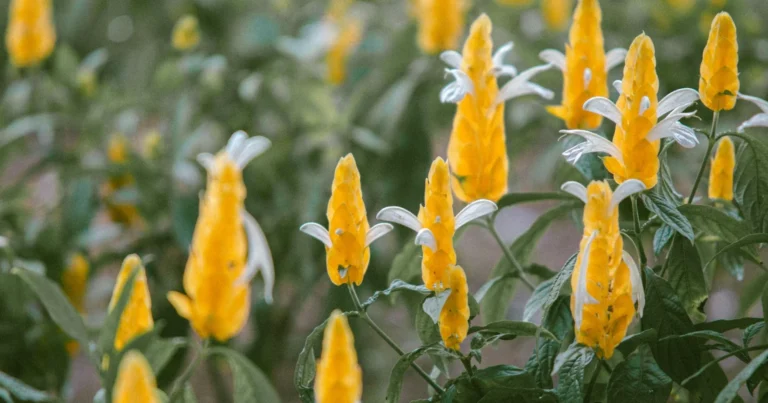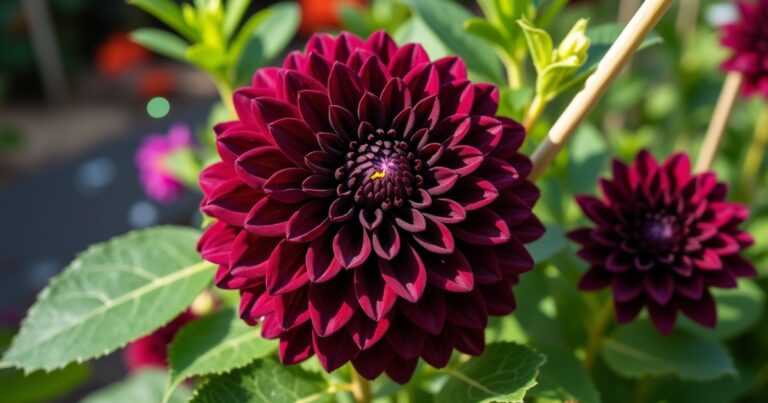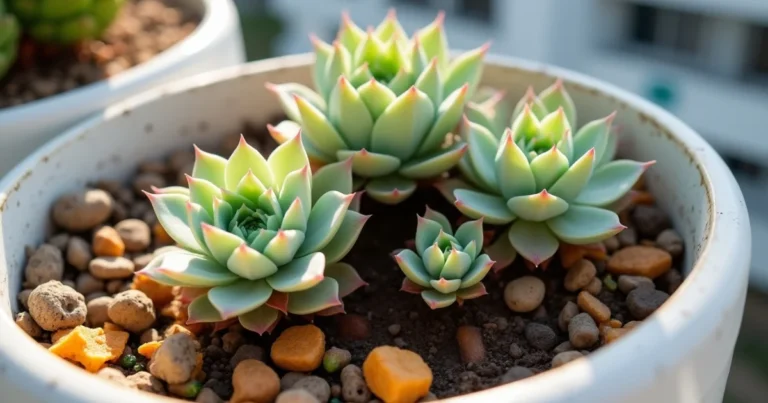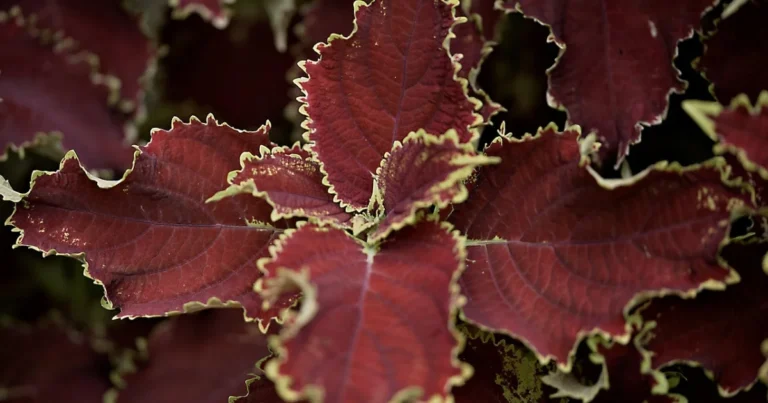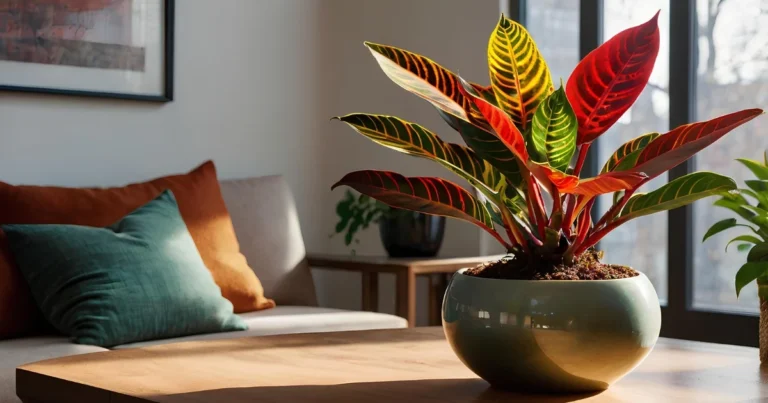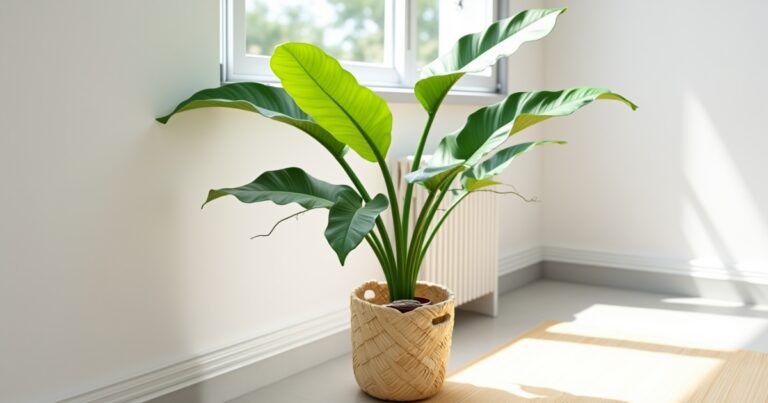Crotons Plants: 7 Secrets for Vibrant, Bold Foliage at Home
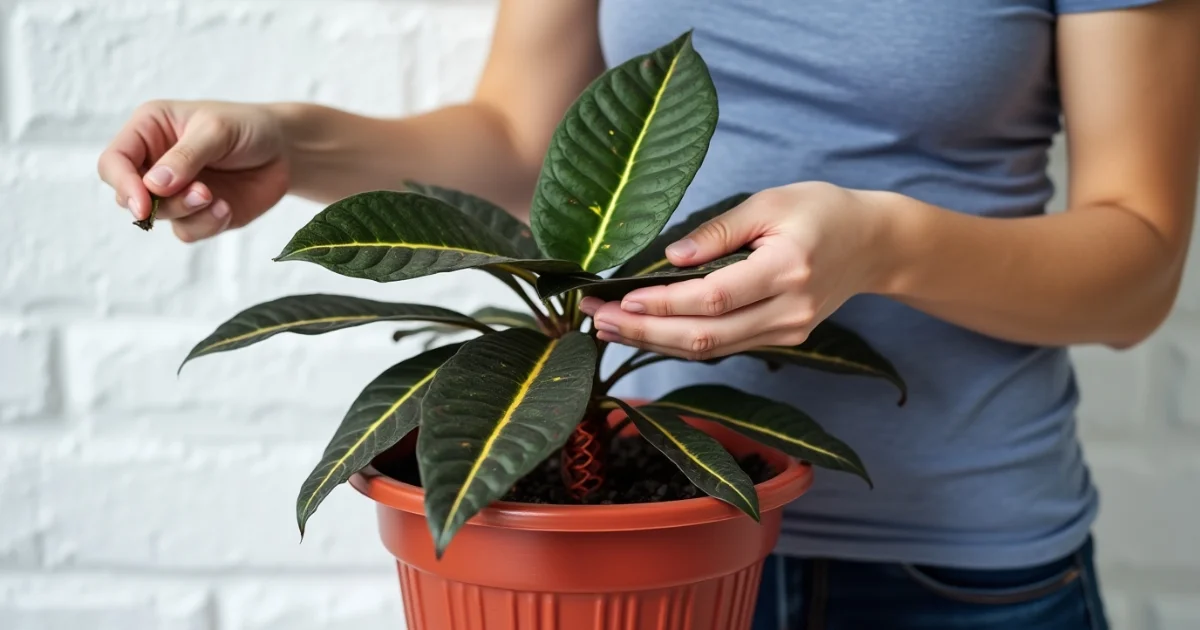
Imagine walking into a room where your crotons plants catch your eye with their bright colors. Now imagine those plants losing their vibrancy, leaves turning dull or falling off. Many of us have been there, wanting that tropical look but finding it hard to keep our plants looking good.
This article shares seven tips to make your crotons stand out. You’ll learn how to keep them colorful all year without the hassle.
These plants are more than just greenery; they’re pieces of living art. But they need care to stay vibrant. This guide will help you avoid common mistakes and keep your plants looking their best. Whether you’re new to plants or have been growing them for years, these tips will help you succeed.
Table of Contents
Introduction to the Colorful World of Crotons Plants:
Crotons plants are more than just houseplants; they’re living art. These tropical beauties add bold colors and patterns to any room. They make great favorites among plant lovers. Their vibrant leaves turn indoor spaces into mini rainforests.
Why Crotons Are Popular Indoor Statement Plants
Imagine a plant that’s easy to care for yet stunning. Crotons plants love bright light but can handle indirect sun too. Their croton leaf designs range from speckled reds to gold and green swirls. They fit both modern and bohemian decor, adding color without the high maintenance.
- Eye-catching patterns that outshine artificial decor
- Adaptable to most indoor light conditions
- Low water needs once established
The Origins and Natural Habitat of Croton Plants
Crotons plants come from Southeast Asia and the Pacific Islands. They thrive in humid jungles. To care for them at home, mimic their natural habitat.
| Aspect | Natural Habitat | Indoor Care |
|---|---|---|
| Light | Filtered sunlight through tree canopies | Bright indirect light near windows |
| Humidity | Rainforest moisture | Regular misting or pebble trays |
Understanding the Unique Appeal of Croton Foliage
No two croton leaf patterns are the same. Their colors come from chlorophyll and carotenoids, like autumn leaves. Genetics and light exposure create their unique stripes, spots, and veins. Unlike typical green plants, crotons change as they grow, providing endless surprises.
Each croton leaf is a canvas of nature’s art. By understanding their roots, you can keep their colors vibrant all year.
Secret #1: Mastering the Perfect Light Conditions
Light is key for your croton’s bright colors. Without enough, colors fade. Too much sun burns the croton leaf. Here are tips to get it right and avoid mistakes in croton care.
Finding the Ideal Brightness for Maximum Color
Put your croton near a window with filtered sunlight. South or east windows are best. Too much sun fades leaves; too little dulls colors.
Shoot for 6–8 hours of bright, indirect light each day. In winter, move it closer to the window for more light.
Seasonal Light Adjustments for Your Croton
| Season | Light Needs |
|---|---|
| Spring | Gradually increase light exposure as days lengthen |
| Summer | Shield from midday sun with sheer curtains |
| Fall | Rotate plant weekly to balance light exposure |
| Winter | Move closer to windows; supplement with grow lights if needed |
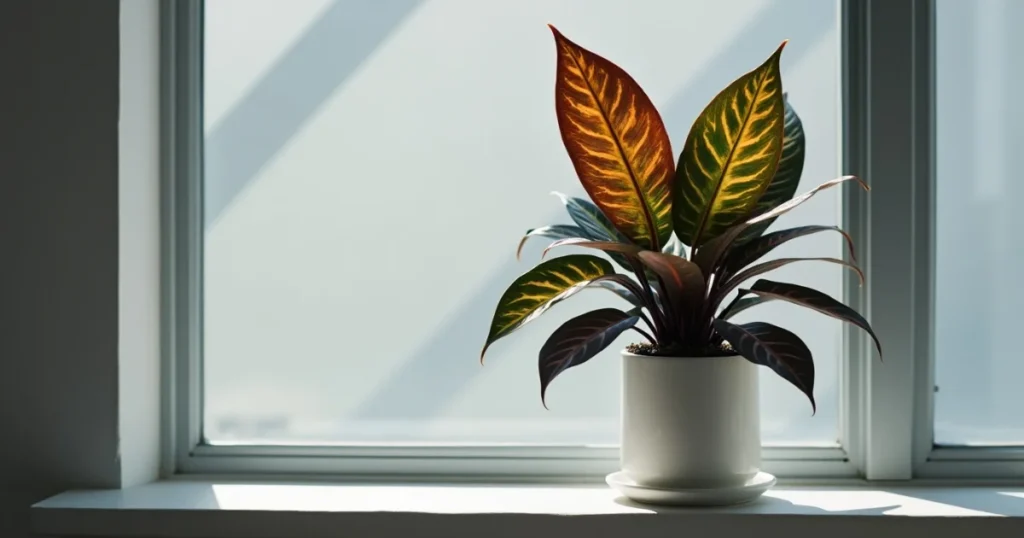
Signs Your Croton Is Getting Too Much or Too Little Light
Look out for these signs:
- Too little light: Leaves turn mostly green, losing red/yellow patterns
- Too much light: Brown, crispy patches appear on croton leaf edges
- Just right: Leaves show sharp, multicolored patterns without burns
Slowly change the plant’s spot over weeks to avoid shock. Check leaves weekly for changes.
Secret #2: The Art of Watering Your Croton Correctly
Learning to water your croton is key in croton care. These plants love soil that’s moist but not too wet. Don’t let them drown in water. Here’s a simple guide to keep your croton healthy.
Check the soil moisture with the finger test. Stick your finger 1–2 inches deep. If the soil feels dry, water it thoroughly. A light pot means it’s time to water. Only water again once the top 2 inches of soil have dried out.
| Issue | Overwatering | Underwatering |
|---|---|---|
| Signs | Yellow leaves, mushy stems | Wilting, crispy edges |
| Fix | Let soil dry completely | Water slowly until it drains |
Use room-temperature water for your croton. Allow tap water to sit for a day to let the chlorine evaporate. In winter, water less often—check every two weeks instead of weekly. When you travel, group plants together under bright indirect light. Use a self-watering spike or ask a friend for help.
Adjust your care for a croton with the seasons. This keeps the leaves looking great. A balanced watering routine is essential for your plant’s health!
Secret #3: Humidity Requirements for Lush Croton Foliage
Keeping the right humidity is vital to stop croton leaf damage. These tropical plants love humid environments, like their rainforest homes. Here, humidity is between 40–60%. This ensures their leaves stay green and healthy.
Creating Humidity Zones in Your Home
Here’s how to boost humidity zones:
- Place near bathrooms or kitchens—areas with natural moisture.
- Group crotons with other tropical plants to create a humid microclimate.
- Use a small tabletop humidifier (e.g., an ultrasonic model) near your plant.
Misting Techniques That Won’t Damage Leaves
Mist croton leaves right to avoid harm:
- Use room-temperature water to prevent shock.
- Mist in the morning so leaves dry before nightfall.
- Aim for a fine mist—avoid heavy droplets that pool on leaves.

Using Humidity Trays Effectively
A humidity tray combines water and pebbles to raise moisture levels. Here’s how to set it up:
| Material | Steps | Why It Works |
|---|---|---|
| Pebbles | Layer in a tray, leaving gaps for airflow. | Raises humidity without soaking roots. |
| Water | Fill tray halfway—keep water below pebble surface. | Evaporation adds moisture without drowning roots. |
| Placement | Position tray under the plant’s pot. | Creates a steady humidity source. |
Use these methods for balanced croton care. Adjust based on your home’s climate—dry climates may need multiple strategies.
Secret #4: Temperature Control for Healthy Crotons Plants
Crotons plants love warm, tropical environments. To keep them healthy, it’s important to maintain stable temperatures. This helps their leaves stay bold and vibrant.
Ideal Temperature Ranges Throughout the Year
Crotons do best in daytime temperatures between 65–85°F (18–29°C). At night, it’s okay to drop 10°F, but below 60°F (15°C) can harm leaves. In winter, keep the temperature at least 60°F.
If it gets too cold, use space heaters or keep plants in insulated rooms. During hot summers, move plants away from radiators and direct sunlight to prevent overheating.
Protecting Your Croton from Drafts and Sudden Changes
Sharp temperature changes can stress crotons. Avoid placing them near:
- Cool drafts from windows/doors
- Hot AC vents or heating units
- Outdoor patios during temperature fluctuations
Wrap plants in frost cloth during winter moves. Use thick curtains near windows to block cold air. For summer, mist leaves early in the day to cool them down without chilling the roots.
Keeping temperatures stable is essential. Check thermometers near your croton and adjust their location with the seasons. With consistent warmth and protection from drafts, your plant’s leaves will stay lush and vibrant.
Secret #5: Soil and Fertilization Strategies
For croton care to thrive, the right soil and nutrients are key. Begin with a mix that drains well to avoid root rot. Use 2 parts quality potting soil, 1 part perlite, and 1 part orchid bark. This mix keeps moisture in and air flowing.
If mixing sounds hard, try pre-made mixes like Miracle-Gro Indoor Potting Mix or FoxFarm Ocean Forest. They’re easy and effective.
- Soil pH should stay slightly acidic to neutral (5.5–6.5) for optimal nutrient uptake.
- Refresh soil yearly to replenish nutrients and aerate roots.
In spring and summer, when plants grow fast, fertilize them. Use a balanced liquid fertilizer like Jobe’s Houseplant Spikes or Dyna-Gro Grow. Dilute it to half strength and feed every 4–6 weeks. Slow down in winter.
Don’t over-fertilize, as it can burn leaves. Watch for crispy edges as a warning.
Each croton varieties needs micronutrients like magnesium and iron for vibrant leaves. Iron deficiency makes veins fade, while potassium shortages cause browning edges. Always water well before fertilizing to prevent root burn. Adjust feeding times based on your plant’s needs. Also, flush soil monthly to remove salt buildup.

Secret #6: How to Prune a Croton House Plant for Bushier Growth
Pruning your croton is more than just cleaning up. It’s a chance to make your plant fuller and encourage new growth. By pruning right, you can keep your plant healthy and even grow more plants. Here’s how to do it well.
Timing Your Pruning Sessions
Choose the right time to prune to avoid stressing your plant. Early spring is best before it starts growing a lot. Look for these signs:
- Leggy stems stretching toward light
- Overgrown areas blocking lower leaves
- Sparse leaves at the base
Don’t prune in winter when it’s dormant. It takes longer to recover.
Proper Cutting Techniques
Use sharp, clean shears and wear gloves to avoid sap irritation. Here’s what to do:
- Sanitize tools with rubbing alcohol to prevent disease.
- Make a cut at a 45-degree angle just above a leaf node.
- Remove dead or yellowing stems first to focus energy on healthy growth.
Don’t cut off more than 1/3 of the plant at once.
Using Pruned Sections for Propagation
Turn trimmings into new plants! Healthy stem cuttings from varieties like ‘Croton Mammy’ or ‘Croton Petra’ root easily. Strip lower leaves, dip ends in rooting hormone, and place in water or moist soil. Keep in bright, indirect light. Roots will show up in weeks—then transplant into pots. This method works best with hardy croton plant varieties found in garden centers.
Popular Croton Plant Varieties for Indoor Growing
Choosing the right croton plant varieties can make your space lively. With hundreds of croton varieties out there, finding the perfect one for your home is easy.
Small-Space Friendly Croton Varieties
These compact plants are great for small spaces. They add color and life without taking up too much room:
| Variety | Max Size | Features |
|---|---|---|
| Croton Mammy | 1-2 feet | Golden speckles on dark leaves; thrives in 12-inch pots. |
| Croton Gold Dust | 2-3 feet | Sunburst yellow dots on green foliage; ideal for desks. |
| Croton Petra Plant | 1-3 feet | Rustic red, orange, and green swirls in a dwarf form. |
Most Colorful Crotons for Maximum Impact
Looking for plants that add a splash of color? These croton varieties will make your space vibrant:
- Croton ‘Oakleaf’: Rustic oak-shaped leaves in crimson and gold.
- Croton ‘Stoplight’: Neon red and green stripes that pop against dark walls.
- Croton ‘Magnificent’: Firework-like patterns in pink, yellow, and crimson.
Rare and Unusual Croton Cultivars Worth Seeking
For something truly unique, check out rare croton plant varieties. Croton ‘Zanzibar’ and Croton ‘Eleanor Roosevelt’ are eye-catching. They’re available at specialty nurseries or through online retailerscut a.
How to Propagate a Croton Plant Successfully
Expanding your croton collection is easy without buying new plants. How to propagate a croton plant is simpler than you think. You can use stem cuttings, air layering, or seeds. Stem cuttings are the easiest and best for beginners.
| Method | Difficulty | Time | Success Rate |
|---|---|---|---|
| Stem Cuttings | Easy | 4–6 weeks | High |
| Air Layering | Moderate | 6–8 weeks | Moderate |
| Seeds | Hard | 8–12 weeks | Low |
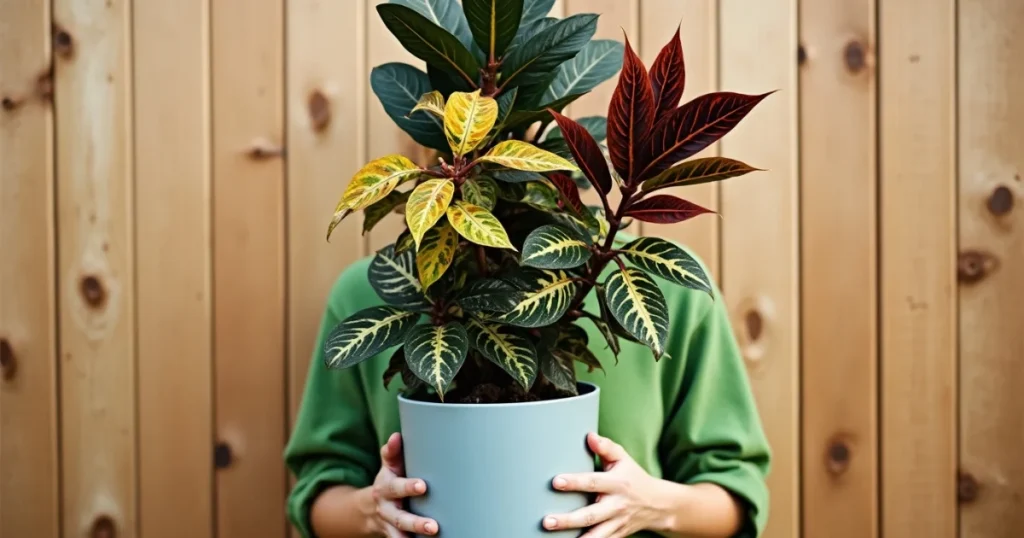
To start stem cuttings, follow these steps:
- Select a healthy stem with vibrant leaves. Avoid stems with flower buds, as blooms drain energy.
- Trim a 4–6 inch piece just below a leaf node. Let the cut callus for 1–2 days to seal sap.
- Plant the stem in well-draining soil. Keep soil moist but not soggy.
- Roots form in 4–6 weeks. Once new growth appears, treat it like a mature plant.
While croton flower blooms are rare indoors, they sometimes appear as small, star-shaped clusters. Their arrival signals your plant is mature and thriving in ideal conditions. Most growers focus on foliage, but flowering shows your care routine is spot-on.
Patience is key. Check for root growth by gently tugging the stem—resistance means roots are forming. Avoid overwatering to prevent rot. Share your propagated plants with friends or enjoy doubling your indoor garden’s color without spending a cent.
Troubleshooting Common Croton Leaf Problems
Even the hardiest croton can face setbacks. Spotting issues early keeps your plant thriving. Here’s how to fix three major problems affecting its health and beauty.
Addressing Color Loss in Croton Foliage
When croton leaf color fades to dull green, check these fixes:
- Low Light: Move plants to brighter indirect light. Rotate the pot weekly to even light exposure.
- Nutrient Deficiency: Feed with balanced fertilizer every 6 weeks during growth. Use a mix high in iron for deep color.
Dealing with Leaf Drop and Browning Edges
Prevent croton leaf damage with these steps:
- Browning Edges: Mist leaves daily or use a humidifier. Trim damaged edges with clean scissors.
- Leaf Drop: Avoid sudden temperature swings. Water only when soil is dry 2 inches deep.
Pest Management for Healthy Crotons
Spot these threats early to protect croton leaf and croton flower health:
- Spider Mites: Wash leaves with neem oil spray. Wipe both sides with a damp cloth.
- Mealybugs: Dab with alcohol-soaked cotton. Isolate the plant to prevent spread.
Regular inspections and gentle treatments keep pests at bay. Healthy plants reward you with bold foliage and occasional croton flower bursts.
Conclusion: Enjoying Your Thriving Croton Collection
Learning to care for crotons is more than just following steps. It’s about building a bond with these lively plants. Every change in light, water, or air affects them, rewarding your efforts with vibrant leaves that change with the seasons.
Watching your crotons grow and change is incredibly rewarding. It shows your hard work in taking good care of them. This is the joy of having crotons in your home.
Crotons can do more than just add greenery to your space. You can mix them with other plants like dracaena or calathea for a jungle look. Or, you can have a single croton stand out in a stylish pot.
They’re perfect for changing up your decor. As you get better at caring for them, try new varieties like ‘Mammy Croton’ or ‘Banana Croton’. Their unique patterns will keep you excited and inspired.
Connecting with other plant lovers online or in local swaps is great. Share tips and trade plants with others. Use hashtags like #CrotonLove or join garden clubs to feel part of a community.
Don’t worry if your crotons shed leaves or change color. It’s all part of their growth. With patience and the right care, your crotons will flourish. They’ll turn your home into a vibrant, tropical oasis.
What are the best light conditions for croton plants?
Croton plants love bright, indirect light. Place them near a south or east window. This gives them plenty of light without burning their leaves.
How often should I water my croton?
Water your croton when the top inch of soil is dry. Don't overwater, as crotons can get root rot from too much water.
What humidity levels do crotons need?
Crotons like high humidity, between 50-65%. You can boost humidity by misting, grouping plants, or using a humidity tray.
How do I prune my croton for bushier growth?
Prune your croton in early spring for bushier growth. Use sharp shears and cut just above a node to encourage new growth.
Can I propagate my croton plant?
Yes! Propagate crotons through stem cuttings. Choose healthy sections, let them callus for a day, and then plant them in a rooting medium.
What are some common issues with croton leaves?
Common issues include color loss from too little light and browning edges from low humidity. Fix these by adjusting light and increasing humidity.
Are croton flowers significant for the plant's health?
While croton flowers are rare indoors, they show your plant is mature and healthy. Focus on good care to promote healthy growth.
What temperature is best for my croton?
Crotons thrive in temperatures between 65-85°F (18-29°C). Keep them away from drafts and sudden temperature changes.
What are some popular croton plant varieties?
Popular varieties include 'Petra', 'Gold Dust', and 'Oakleaf'. Each offers unique leaves and colors for different tastes and spaces.

